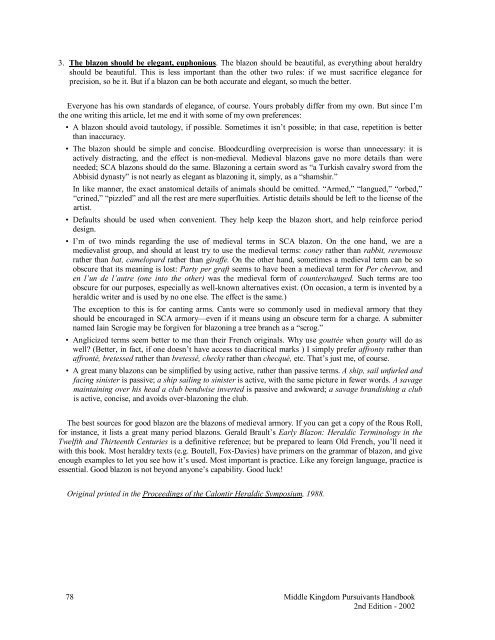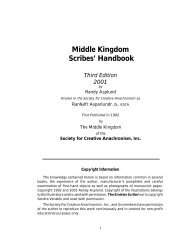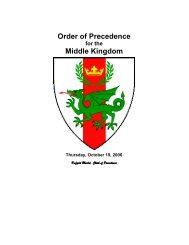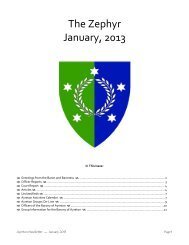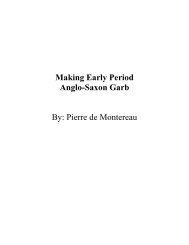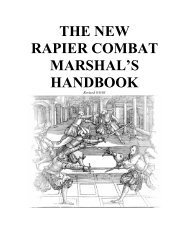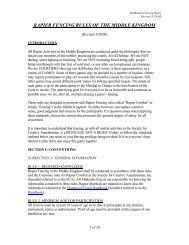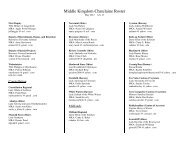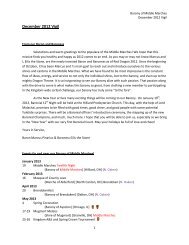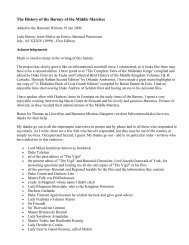Middle Kingdom Pursuivants Handbook 2nd Edition - Midrealm ...
Middle Kingdom Pursuivants Handbook 2nd Edition - Midrealm ...
Middle Kingdom Pursuivants Handbook 2nd Edition - Midrealm ...
Create successful ePaper yourself
Turn your PDF publications into a flip-book with our unique Google optimized e-Paper software.
3. The blazon should be elegant, euphonious. The blazon should be beautiful, as everything about heraldryshould be beautiful. This is less important than the other two rules: if we must sacrifice elegance forprecision, so be it. But if a blazon can be both accurate and elegant, so much the better.Everyone has his own standards of elegance, of course. Yours probably differ from my own. But since I’mthe one writing this article, let me end it with some of my own preferences:• A blazon should avoid tautology, if possible. Sometimes it isn’t possible; in that case, repetition is betterthan inaccuracy.• The blazon should be simple and concise. Bloodcurdling overprecision is worse than unnecessary: it isactively distracting, and the effect is non-medieval. Medieval blazons gave no more details than wereneeded; SCA blazons should do the same. Blazoning a certain sword as “a Turkish cavalry sword from theAbbisid dynasty” is not nearly as elegant as blazoning it, simply, as a “shamshir.”In like manner, the exact anatomical details of animals should be omitted. “Armed,” “langued,” “orbed,”“crined,” “pizzled” and all the rest are mere superfluities. Artistic details should be left to the license of theartist.• Defaults should be used when convenient. They help keep the blazon short, and help reinforce perioddesign.• I’m of two minds regarding the use of medieval terms in SCA blazon. On the one hand, we are amedievalist group, and should at least try to use the medieval terms: coney rather than rabbit, reremouserather than bat, camelopard rather than giraffe. On the other hand, sometimes a medieval term can be soobscure that its meaning is lost: Party per graft seems to have been a medieval term for Per chevron, anden l’un de l’autre (one into the other) was the medieval form of counterchanged. Such terms are tooobscure for our purposes, especially as well-known alternatives exist. (On occasion, a term is invented by aheraldic writer and is used by no one else. The effect is the same.)The exception to this is for canting arms. Cants were so commonly used in medieval armory that theyshould be encouraged in SCA armory—even if it means using an obscure term for a charge. A submitternamed Iain Scrogie may be forgiven for blazoning a tree branch as a “scrog.”• Anglicized terms seem better to me than their French originals. Why use gouttée when goutty will do aswell? (Better, in fact, if one doesn’t have access to diacritical marks ) I simply prefer affronty rather thanaffronté, bretessed rather than bretessé, checky rather than checqué, etc. That’s just me, of course.• A great many blazons can be simplified by using active, rather than passive terms. A ship, sail unfurled andfacing sinister is passive; a ship sailing to sinister is active, with the same picture in fewer words. A savagemaintaining over his head a club bendwise inverted is passive and awkward; a savage brandishing a clubis active, concise, and avoids over-blazoning the club.The best sources for good blazon are the blazons of medieval armory. If you can get a copy of the Rous Roll,for instance, it lists a great many period blazons. Gerald Brault’s Early Blazon: Heraldic Terminology in theTwelfth and Thirteenth Centuries is a definitive reference; but be prepared to learn Old French, you’ll need itwith this book. Most heraldry texts (e.g. Boutell, Fox-Davies) have primers on the grammar of blazon, and giveenough examples to let you see how it’s used. Most important is practice. Like any foreign language, practice isessential. Good blazon is not beyond anyone’s capability. Good luck!Original printed in the Proceedings of the Calontir Heraldic Symposium, 1988.78 <strong>Middle</strong> <strong>Kingdom</strong> <strong>Pursuivants</strong> <strong>Handbook</strong><strong>2nd</strong> <strong>Edition</strong> - 2002


